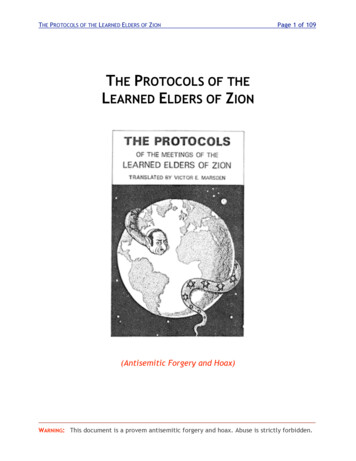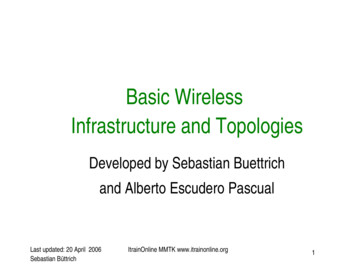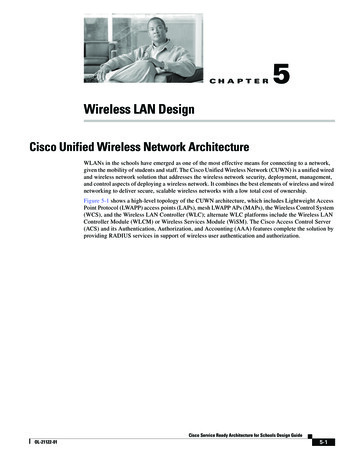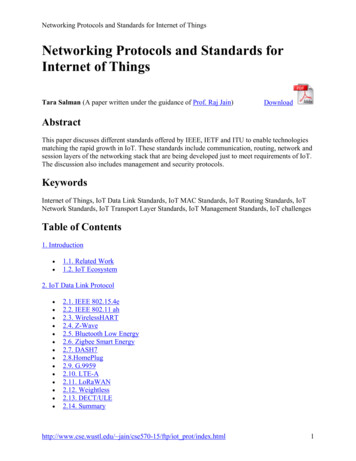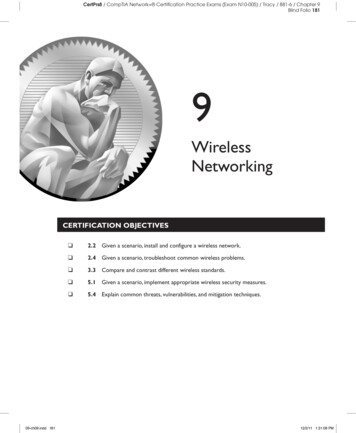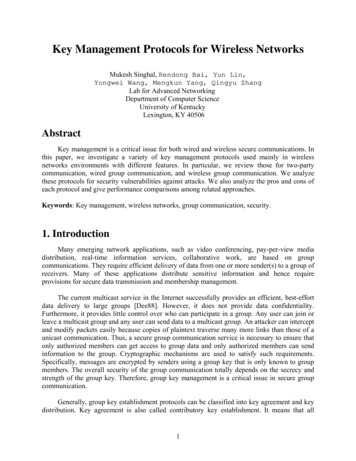
Transcription
Key Management Protocols for Wireless NetworksMukesh Singhal, Rendong Bai, Yun Lin,Yongwei Wang, Mengkun Yang, Qingyu ZhangLab for Advanced NetworkingDepartment of Computer ScienceUniversity of KentuckyLexington, KY 40506AbstractKey management is a critical issue for both wired and wireless secure communications. Inthis paper, we investigate a variety of key management protocols used mainly in wirelessnetworks environments with different features. In particular, we review those for two-partycommunication, wired group communication, and wireless group communication. We analyzethese protocols for security vulnerabilities against attacks. We also analyze the pros and cons ofeach protocol and give performance comparisons among related approaches.Keywords: Key management, wireless networks, group communication, security.1. IntroductionMany emerging network applications, such as video conferencing, pay-per-view mediadistribution, real-time information services, collaborative work, are based on groupcommunications. They require efficient delivery of data from one or more sender(s) to a group ofreceivers. Many of these applications distribute sensitive information and hence requireprovisions for secure data transmission and membership management.The current multicast service in the Internet successfully provides an efficient, best-effortdata delivery to large groups [Dee88]. However, it does not provide data confidentiality.Furthermore, it provides little control over who can participate in a group. Any user can join orleave a multicast group and any user can send data to a multicast group. An attacker can interceptand modify packets easily because copies of plaintext traverse many more links than those of aunicast communication. Thus, a secure group communication service is necessary to ensure thatonly authorized members can get access to group data and only authorized members can sendinformation to the group. Cryptographic mechanisms are used to satisfy such requirements.Specifically, messages are encrypted by senders using a group key that is only known to groupmembers. The overall security of the group communication totally depends on the secrecy andstrength of the group key. Therefore, group key management is a critical issue in secure groupcommunication.Generally, group key establishment protocols can be classified into key agreement and keydistribution. Key agreement is also called contributory key establishment. It means that all1
participants take equal part in the key generation and guarantee for their part that resulting key isfresh. Key distribution means that the key is generated by one party and distributed to all otherparticipants. Key distribution is more suitable to large groups.The group key management system must be able to cope with the demands of variousapplications. Besides confidentiality, integrity, and authenticity requirements, the followingfeatures are desirable in a group key management system for dynamic groups.- Scalability. The size of a multicast group may vary from a few to tens of thousands. The rate ofjoin/leave requests and the expected lifetime of a member may vary largely in differentapplications. The group key management system should not make arbitrary assumptions aboutgroup size. Membership changes should only affect a small subset of members so that the systemcan support large dynamic groups.- Forward and backward secrecy. Forward secrecy means that a departed member can't accessfuture data after it has left the group. To keep forward secrecy, the system must change the groupkey after a current member leaves, or is evicted from the system. Backward secrecy means that ajoining member can't access past group data. To keep backward secrecy, the system must changethe group key after a new member joins. The process of establishing new group key securelyupon membership changes is referred to as group rekeying.- Reliability. Since IP Multicast only provides best-effort data delivery, rekeying messages maybe lost or delayed. If a receiver didn't get the rekeying information, it can't decrypt messagesencrypted with the new group key. More seriously, if the sender missed new group key, data maybe exposed to departed members because the sender still uses old key to encrypt group data. Sothe system must provide reliable transport of rekeying messages, or provide a recoverymechanism for a member to get missed rekeying messages in a timely manner.- Resistance to attacks. Since we assume the network infrastructure is insecure, unauthorizedmembers may eavesdrop on the group communication. A subset of departed members maycollude to try to discover new group keys. A subset of current members may collude to try todiscover the keying material of other valid members to impersonate the victims. Thus, a keymanagement system should be resistant to attacks from both inside and outside the group.- Protocol Independence. To be applicable as widely as possible, the system should not make anyassumption about underlying multicast protocols and routing algorithms.Recently, mobile computing has become very popular due to dramatic decrease in weightand cost of mobile devices, and the increase of bandwidth and new wireless services. Introducingmobile users into group communications greatly improves the flexibility, availability of groupapplications. However, power, storage, and bandwidth limitations restrict the ability of mobileusers to participate in the group as fixed hosts. The broadcast nature of wireless medium makesattacks easier, and host mobility increases the complexity of membership dynamics. The groupkey management system must consider the following issues in mobile wireless environments:- Simplicity. The system only requires little additional software/hardware in mobile hosts.2
- Efficiency. To make the optimal use of limited processing and communication resources, thesystem must be both communicationally and computationally efficient.- Robustness. The system should be able to work gracefully in case of communicationdisruptions and minimize the effect as far as possible.- The role of base stations. Except in ad hoc networks, all mobile hosts rely on base stations torelay their communication. "What kind of role should the base station play?" and "To whatdegree we can trust them?" are two important questions.In case of ad hoc networks which have no pre-existing infrastructure, secure groupcommunication is more complex. The lack of infrastructure means the lack of central entities,fixed routers, name servers, certificate authorities, and so on. Thus standard key managementtechniques in wired networks can not be applied straightforwardly. The network topology of adhoc networks may change rapidly, so any protocol bound closely with network topology is notsuitable. These are all concerns we should take into account when going a further step into adhoc environments.A variety of protocols for secure group communication have been proposed in literature inrecent years. We summarize some of the representative protocols in this survey. We brieflyintroduce these protocols and examine their pros and cons. The rest of this paper is organized asfollows. In Section 2, we describe the necessary background on mobile networks andcryptography. In Section 3, we introduce some typical key management protocols for two-partycommunications. In Section 4, we discuss several key management protocols for groupcommunications. In Section 5, we describe key exchange protocols in wireless networks and wedraw some conclusions in Section 6.2. Background2.1 The Specific Nature of Mobile EnvironmentsSecurity, authentication and access control are vital features that must be present in anycommunications network. These features are more important in case of wireless mobilecommunications than in wired communications because of the widely shared nature of thewireless medium. In fact, the mobile wireless environment has some specific characteristicswhich influence the feasibility and efficiency of the security protocols: The unique characteristics of the wireless medium. A wireless link is likely to be limited inbandwidth. Also the error rates on a wireless link is much higher than that of a wired link. Different types of communication paths involved, one of which is radio link, particularlyvulnerable to attack. Location privacy. Any leakage of specific signaling information on the network can lead toan eavesdropper to approximately “locate” the position of a subscriber and thus hinderingthe subscriber’s privacy.3
Computational limitation. Compared with typical communications devices, the mobilestation is limited in computational power. In fact, mobile and base stations have differentlevels of computational power.2.2 Mobile Security RequirementsThe following presents the requirements in radio link security [BM98]: Mutual authentication of the mobile and base stations. Confidentiality and integrity of the information exchanged between the mobile and basestation. Confidentiality of the identity of the mobile station. Acceptable cost of the computation involved to the mobile station.Compared with radio link security, the end-to-end security between mobile users and theircommunications partners typically includes confidentiality and integrity of user data, nonrepudiation. The detailed requirements will vary depending on the applications.2.3 CryptographyTraditional cryptography is based on the sender and receiver of a message knowing and using thesame secret key: the sender uses the secret key to encrypt the message, and the receiver uses thesame secret key to decrypt the message. This method is known as secret-key or symmetriccryptography. The main problem with this method is having the sender and the receiver agree onthe secret key that an eavesdropper will not be able to determine.The second class of cryptography methods is public-key cryptography or asymmetriccryptography. In a public-key cryptosystem, every entity has a pair of keys: a public key and aprivate key. Data encrypted with the public key can be decrypted only with the correspondingprivate key. The public key is published, so that anyone can encrypt messages with it. But theprivate key is kept secret, thus only the key owner can decrypt the messages correctly. That's theessence of public-key cryptography introduced by Diffie and Hellman in 1976.Key management consists of a set of techniques and procedures supporting theestablishment and maintenance of keying relationships between authorized parties. A keyingrelationship is the state wherein communicating entities share common data (keying material) tofacilitate cryptographic techniques. This data may include public or secret keys, initializationvalues, and additional non-secret parameters [MOV96].The vast majority of key agreement protocols are based on Diffie-Hellman key exchangeprotocol. Diffie-Hellman key exchange protocol is a typical contributory key exchange protocolin which the session key is established from the contribution components provided by all theentities in the communication group.The following table demonstrates how the Diffie-Hellman key exchange protocol works.The goal is for Alice and Bob (two entities in communication) to agree upon a shared secret thatan eavesdropper will not be able to determine. This shared secret is used by Alice and Bob toindependently generate keys for symmetric encryption that will be used to encrypt the data4
stream between them. The "key" aspect of this approach is that neither the shared secret nor theencryption key ever travel over the network.Alice and Bob agree on two numbers "p" and "g"Alice picks a secret number "a"Bob picks a secret number "b"Alice computes her public number :x ga mod pBob computes his public number:y gb mod pAlice and Bob exchange their public numbers"g" is called the base or generatorAlice’s secret number aBob’s secret number bAlice’s public number xBob’s public number yAlice knows p, g, a, x, yBob knows p, g, b, x, yka (gb mod p)a mod p (gb)a mod p gba mod pkb (ga mod p)b mod p (ga)b mod p gab mod pgba mod p gab mod pi.e., ka kbAlice computes ka ya mod pBob computes kb xb mod pAlice and Bob then agree on the session keykab ka kbTable 1: Diffie-Hellman key exchange protocol.There are requirements on the numbers picked (e.g., minimum size, ranges, etc.), which isknown as “Diffie-Hellman parameters”. The value of p should be larger than 2 and g should bean integer that is smaller than p. Besides, a and b should less than p-1.2.4 Terminology and NotationsThe following notations will be used throughout the paper unless noted otherwise:M:mobile entityB:base station x’s public keyPK x : x’s private keyPK x :Cert ( x ) : x’s certificateNx:random challenge generated by xx encrypted with key K{x} K :session key between a and bk ab :s:shared secretrx :random value chosen by xTX :N:Mi :h:〈 l, v〉 :Ti :time stamp issued by Xnumber of protocol parties (group members)i-th group member; i {1,., N}height of a treev-th node at level l in a treeM i ’s view of the key tree5
T̂i :p, q :α:M i ’s modified tree after membership operationprime integersexponentiation base3. Key Establishment in Two-Party CommunicationsIn this section several protocols for establishing a secret key between two nodes are discussed.These protocols provide link-level security for mobile communication. That is security isprovided in a machine-to-machine manner, compared with end-to-end security. These protocolsalso form the basis of establishing a secret key among a group of nodes.3.1 Beller-Chang-Yacobi ProtocolsBeller et al. [BCY91][BCY92][BCY93][BM98] proposed a series of protocols which combineasymmetric and symmetric cryptographic algorithms in order to meet the specific requirementsimposed by the asymmetry of the computational power between a mobile host and a base station.The public key cryptosystem underlying BCY protocols uses Modulo Square Root (MSR)technique in which encryption and decryption are implemented by calculating a modulo squareand a modulo square root, respectively. Computation power involved is acceptable for a mobilestation.BCY protocol family includes three variants: Basic MSR protocol, Improved MSR (IMSR)protocol, and MSR DH protocol. Each has different feature related to security.The Basic MSR protocol works as follows:1. BÆM: B, PK B 2. MÆB: {k BM }PK B3. MÆB: {M , Cert ( M )}k BMFirstly, the base station B sends its public key PK B to the mobile station M. M then uses PK B to encrypt the session key k BM and sends it to B. Only the base station can decrypt the sessionkey using its private key. At the same time, the mobile also sends its identity and certificateencrypted by k BM for authentication to the base station. Messages in steps 1 and 2 are based onpublic key cryptography while message in step 3 uses secret key cryptography.In fact, this protocol doesn’t allow authentication of the base station at the mobile host.This means, anyone can masquerade as the base station and initiate a session with a mobile hostby sending his own public key and id in step 1.To address this problem, the IMSR protocol adds Cert (B ) , the certificate of the basestation, in the first message. Besides this feature, the IMSR protocol is the same as the BasicMSR protocol.The IMSR protocol works as follows:1. BÆM: B, PK B , Cert ( B)2. MÆB: {k BM }PK B3. MÆB: {M , Cert ( M )}k BM6
Upon receiving message 1, the mobile decrypts Cert (B ) using the public key of the CertificateAuthority (CA), and then it verifies the identity of the base station. The owner of a certificateshould keep its certificate secret from other mobile users and eavesdroppers to prevent othersfrom masquerading.Note that the IMSR protocol is not immune to replay attack. If a malicious attacker copiesmessages {k BM }PK and {M , Cert ( M )}k BM , replays them later after the session between M and BBends, the base station can not determine if these messages indeed came from M . Even if theattacker doesn’t know k BM and can’t do anything further, at least the session initiated by theattacker will be incorrectly charged to M. Situation might be worse if the old session key k BM isobtained by the attacker, since using it to decrypt message {M , Cert ( M )}k BM the attacker canacquire Cert (M ) , which is all it needs to masquerade as M.MSR DH protocol works as follows:1. BÆM: B, PK B , Cert ( B)2. MÆB: {k}PK , {M , PK M , Cert ( M )}kBThis protocol adopts the idea of Diffie-Hellman protocol. The session key is not transmitteddirectly. PK B and PK M are exchanged to establish a shared secret s between B and M usingDiffie-Hellman technique (Please refer to Section 2.3 for the details). The session key iscalculated as encryption of k with s.With improved security, the protocol requires more computation since both parties need tocalculate a full modular exponentiation to establish the session key.3.2 Beller-Yacobi ProtocolThe Beller-Yacobi protocol [BM98][BY93] adds a challenge to address the replay problem inthe previous protocols. The reason why this algorithm is preferred is that the digital signature isused on the challenge at the mobile and signature can largely be executed before choosing themessage to be signed, i.e., the mobile can do most of the work when idle. The protocol runs inthe following steps:1. BÆM: B, PK B , Cert ( B)2. MÆB: {k BM } PK B3. BÆM: {N B }k BM4. MÆB: {M, PK M , Cert ( M ), {N B } PK }k BMMThe first two messages are same as in the IMSR protocol. Upon receiving the encrypted messagefrom M in step 2, B decrypts the message and gets the session key k BM . Then B sends to M achallenge N B (a large random number) encrypted using k BM . The mobile then signs N B using itsprivate key and return it to B together with its id, public key PK M , and certificate, all encryptedwith k BM . Finally, B decrypts this message using k BM and decrypts N B using PK M and checksif the N B is the one expected.This protocol is resistant to replay attacks. If an attacker replays a message {k BM } PK , itBcan not get the correct N B since it doesn’t know k BM . Even if it knows an old session key and7
can get the correct N B , it still can not generate correct {N B }PK since it doesn’t know the privateMkey of M. In both of the cases, the attacker can not respond with the correct message in step 4.However, if an attacker is a registered user of B, and at the same time it can talk with Mas a base station, it can succeed in spoofing as M as follows:A is an attacker.1. BÆA: B, PK B , Cert ( B)2. AÆB: {k BA } PK B3. BÆA: {N B }k BA4. AÆM: A, PK A , Cert ( A)5. MÆA: {k AM }PK A6. AÆM: {N B }k AM7. MÆA: {M, PK M , Cert ( M ), {N B } PK }k AMM M8. AÆB: {M, PK , Cert ( M ), {N B }PK }k BAMA starts a session with B and gets the random naunce N B for the session. Then A turns to initiatea talk with M pretending as a base station. In this way, A gets the critical message {M,PK M , Cert ( M ), { N B } PK } from M and forwards it to B after encrypting it using the session keyMk BA . B can not detect the threatening standing between M and it.An improved BY protocol fights this attack by signing not only N B but together with thesession key and the ids of the mobile itself and the base. It works as follows:1. BÆM: B, PK B , Cert ( B) , N B2. MÆB: {k BM } PK , {M , PK M , Cert ( M )}k BM , {hash( B, M , N B , k BM )} PK BM3. BÆM: {N B }k BMThus, the attacker A standing between M and B like above can’t succeed by just forwarding themessage containing M’s signature which is acquired in another session with M, even if Achooses the same session key k BA with B as the one with M k AM .1. BÆA: B, PK B , Cert ( B) , N B2. AÆM: A, PK A , Cert ( A), N B3. MÆA: {k AM }PK , {M , PK M , Cert ( M )}k AM , {hash ( A, M , N B , k AM )}PK AMNow the message that B is expecting from A is{k BA } PK , {M , PK M , Cert ( M )}k BA , {hash ( B, M , N B , k BA )} PK BMThe first two parts can be generated by A from message 3. However A can’t generate the lastcomponent correctly. So A can’t masquerade as M talking with B.3.3 Aziz and Diffie’s ProtocolThe Aziz and Diffie protocol [AD94] [BM98] uses both public-key and secret-key cryptographytechniques. The public-key cryptography provides the means for session key setup andauthentication. Secret-key cryptography is used to provide privacy for bulk data transmission.The protocol works as follows:8
alg-list: a list of flags representing secret-key algorithms provided by the mobile;sel-alg: the flag representing the particular algorithm selected by the base station;X B , X M : are contribution components for the session key provided by B and M,respectively.1. M B : Cert ( M ), N M , a lg list2. B M : Cert ( B ), { X B } PK , sel a lg, hash {X B }PK M , sel a lg, N M , a lg list PK {M()}B3. MÆ B: { X M } PK , {hash({ X M }PK , { X B }PK )}PK BBMMFirst, M sends to B its certificate, a challenge and a list of algorithms. The certificate binds the idof M with M’s public key. Using corresponding CA’s public key, B can decrypt Cert (M ) andget the public key of M. N M is to avoid replaying attacks. B responds with its certificate andsession key contribution component encrypted by PK M , and the preferred algorithm. To avoidthe man-in-the-middle attack, a digest of vulnerable items is calculated and appended to themessage. Similarly, M responds to B with its contribution component for the session key. Withthe knowledge of both contribution components, both sides can calculate the session key.In the phase of session key establishment, the mobile has to perform two computationallyexpensive operations based on public key cryptography: one decryption to get X B in step 2, andone encryption to do the digital signature in step 3.In [M95], Meadows showed a possible attack on this protocol as follows.A is an attacker who is also a registered user of B.1. M B : Cert ( M ), N M , a lg list2. A B : Cert ( A), N M , a lg list3. B A : Cert ( B ), { X BA } PK , sel a lg, hash {X BA }PK A , sel a lg, N M , a lg list PK {A({ (, sel a lg, {hash ({X)})}, a lg list )}4. A M : Cert ( B ), { X BA } PK , sel a lg, hash {X BA }PK M , sel a lg, N M , a lg listM5. B M : Cert ( B ), { X BM } PK MBM}PK M, sel a lg, N MBPK B PK B (intercepted and discarded by A)6. MÆ B: { X M } PK , {hash({ X M }PK , { X B }PK )}PK BBMMA sits between M and B. Just after M starts a session with B, A initiates another talk with B byreplaying M’s challenge N M . Then A forwards to M the B’s contribution component for thesession key between A and B (steps 3,4) while discarding the B’s contribution component for thesession key between M and B. Thus, the mobile calculates the session key with X BA and X Mwhile the base station calculates that with X BM and X M . This means the mobile and the basestation agree on the session key with different values and they can’t do the following encryptionand decryption correctly.3.4 Park’s ProtocolPark’s protocol [BP98][P97] is a modified version of an earlier protocol by Yacobi and Shmuely[YS89] and it works as follows: 1. BÆ M: g PK B rB (In the Yacobi-Shmuely protocol, “ PK B rB ” is sent.)2. MÆ B: PK M rM9
The public keys of two sides are PK B g PK B and PK M g PK M respectively. The session key is K BM g rB rM , which is calculated by M as K BM ( g PK B rB PK B ) rM and by B as K BM ( g PK M rM PK M ) rBCompared with the Yacobi-Shmuely protocol in which both the mobile host and the basestation have to do two exponentiation operations, this protocol require the mobile M to performonly one exponentiation operation, which makes it more suitable for key establishment inwireless environments.In [MM98], an attack is shown upon the Park’s protocol. Suppose an attacker A knows an old session key K BM g rB rM and stores the exchanged information g PK B rB , PK M rM , whichwas to established K BM . A can masquerade as B successfully as follows.K ' BM is the new session key. 1. AÆ M: g PK B rB2. MÆ A: PK M rM'3. A: ( PK M rM' ) – ( PK M rM ) rM' rM ; ' ''K ' BM ( g PK B rB PK B ) rM rM K BM ( g PK B rB g PK B ) rM rM g rB rM g rB rMIn the same way the Yacobi-Shmuely protocol can be attacked in both directions due toits symmetry of the message exchange.In fact, anyone A can run the protocol like B together with M by constructing the first message as ( PK B ) 1 g rA ( g PK B ) 1 g rA g PK B rA . The steps followed as normal, i.e., A and Mshould agree on a session key K AM g rA rM finally. M takes the communication partner as B,however, it is NOT B actually. In another word, there is no authentication of B at M.3.5 ASPeCT ProtocolASPeCT [BP98][HP98] is the abbreviation of Advanced Security for Personal CommunicationTechnologies. This protocol is used within the third generation mobile communications system,also known in Europe as UMTS (Universal Mobile Telecommunications System) for securebilling between a mobile user and a value-added service provider (VASP). The protocol is in factdivided into two separate component protocols: Authentication and Initialization Protocol,Payment Protocol. The former does authentication in various degrees between the user and theVASP, establishes the session key and initializes the subsequent payment protocol. The latter isresponsible for making payments for a value-added service. Due to the subject of this paper, wejust discuss the Authentication and Initialization Protocol, which is based on asymmetriccryptography.The protocol uses three functions h1, h2 and h3 that are implemented using one-way hashfunctions. A trusted third party (TTP) is involved to work as a certificate authority. k is atemporarily used key computable by TTP. PK B g b is the public key contained in Cert(B).ch data is the charging information. pay data is the data needed to initialize the PaymentProtocol. T is a time stamp.The following are the steps of the protocol:1. MÆ B: g rM , {id M }k , TTP2. BÆ M: {rB , h2 ( K MB , rB , B ), ch data, T , Cert ( B)}k10
3. MÆB: {{h3 ( g rM , g b , rB , B, ch data , T , pay data )}PK , pay data}K MBMBetween steps 1 and 2, the process is omitted that B consults the TTP for the public key of M(TTP also includes the value of k and a time stamp T in the respond message). In step 2, B sendsthe charging information to M. In step 3, M signs its payment and sends to B. The hashingoperation avoids message compromise during transmission without detection. The time stampadded in the message aims at preventing replay attacks. Signature prevents repudiation. Thesession key is calculated by M as K MB h1 (rB , (( PK B ) rM )) h1 (rB , (( g b ) rM )) and by B asK MB h1 (rB , ( g rM ) b ) .3.6 Accelerating Key Establishment Protocols for Mobile CommunicationPublic-key cryptosystems have more advantages than secret-key cryptosystems, but they are notfully utilized because of their computational overhead and the low computing power of a mobilestation. Lee et al. [LHYC98] proposed techniques for accelerating some of the above keyestablishment protocols between a mobile station and a base station. The basic idea is to enable amobile station to borrow computing power from a base station without revealing its secretinformation. The proposed techniques use SASC (server-aided secret computation) protocol,which can be used to significantly accelerate RSA signature generation. The objective of SASCprotocols is to enable the client to efficiently compute ms mod n with the aid of the server, wherem is a message, s is private key, and n is the product of two large primes.Lee et al. proposed techniques for several key establishment protocols, and we willdescribe the acceleration of improved BY scheme. A mobile station need to execute two publickey operations and a private key operation in this key establishment protocol (section 3.2). Theoperation that requires extensive computation is the signature generation of the mobile stationusing its private key. The approach to overcome this problem is to make use of theprecomputable property of ElGamal algorithm. Their insight is as follows: When the mobilestation generates the signature { h ( B , M , N B , x )} PK , the signature can be precomputed and stored 1Min advance as it is independent of the message h(B, M, NB, x) to be signed.The precomputation (gr mod p) uses Beguin and Quisquater's server-aided DSS (DigitalSignature Standard) scheme [BQ95], which is a splitting-based technique. The session random r(the secret of mobile station) is decomposed into several pieces and sent to the base station. Thelatter computes exponentiation for every piece and returns them to the mobile station, and themobile station combines these results to get the signature. The precomputation works as follows:1. The mobile station randomly chooses xis and bis which satisfy r im 01 x i b i , where 0 xibi h, and then, it sends bis to the base station.2. The base station computes g b mod p , for 0 i m-1, and then, it returns them to themobile station.3. The mobile station computes g r im 01 ( g b ) x mod p .iiiThe analysis shows that this approach can present outstanding accelerating performance.However, it still remains an open question whether it is possible to accelerate significantly RSAsignatures using an insecure server with the possibility of active attacks: that is, when the serverreturns false values to get some part of secret. Moreover, the rapid advances in computing powerof hardware have been resulting in drastic improvements in large-number arithmetic11
computations. So the bottleneck probably will shift from computation to other issues such ascommunication delay.4.Key Management Protocols for Group Communication4.1. Tree-Based Key ManagementWith the rapid development of deploying secure grou
Key management is a critical issue for both wired and wireless secure communications. In this paper, we investigate a variety of key management protocols used mainly in wireless networks environments with different features. In particular, we review those for two-party communication, wired group communic
